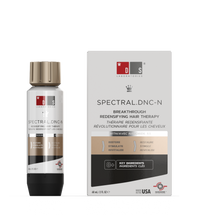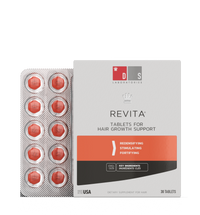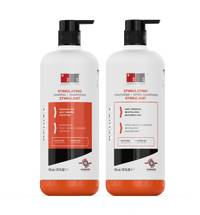
Hair loss affects both men and women. To many, this news is surprising, as most of us associate hair loss with men of a certain age. Yet, the reality is that 40% of people with hair loss are women. That’s right - you read that correctly: hair loss afflicts both men and women almost equally. And one of the most common causes of hair loss in both sexes is androgenetic alopecia. Let’s dissect the roots of androgenetic alopecia and explore the differences between male and female pattern baldness.
What Is Male and Female Pattern Baldness?
Medical personnel often call this type of hair loss androgenetic alopecia. Although there is still speculation as to what causes it, male and female pattern baldness is likely the result of genetics. There are likely several genes involved with androgenetic alopecia, but science can confirm that variations on the AR gene cause certain people to have an increased sensitivity to dihydrotestosterone (DHT) in hair follicles.
DHT is a derivative of the male sex hormone (or androgen) testosterone. When hair follicles are exposed to DHT, it can lead to shrinkage of hair follicles, making hair thinner and more delicate over time. Eventually, the hair stops growing altogether.
You may be thinking: why does a condition that primarily involves male sex hormones affect women? The reason this occurs is that women also have androgens. Indeed, women need testosterone to make estrogen, the dominant female sex hormone. Nonetheless, DHT affects hair follicles much the same in both sexes, but there are some differences in how it develops.
Difference #1 - The Distribution of Hair Loss Differs Between Men and Women
Male pattern hair loss follows a typical “pattern” or distribution across the scalp. It usually starts in the front of the head and recedes toward the crown. Often, the receding hairline leaves a ‘V’ shape, where the hair remains near the center point of the forehead for some time before it too recedes. Men can also have vertex balding, or crown balding, where it starts at the crown or center of your head and balds in a circle. When left untreated, men can go completely bald if they have androgenetic alopecia.
Female pattern hair loss occurs differently from males. Women typically experience a widening part line, where initially the hair looks thinner, and the line begins to expand in width. Women can also get thinning around the temples as well. However, unlike men, women will generally not go bald because of this form of hair loss.
Difference #2 - The Age of Onset
Men are more likely to struggle with male pattern baldness earlier in life than their female counterparts. Men can get male pattern baldness as early as their late teens to early 20s. However, it is more common to get it after 30.
On the contrary, women are not likely to suffer from female pattern baldness before their 40s. Indeed, it usually shows up in the 40s, 50s, and 60s.
Difference #3 - Hair Loss Is Considered More “normal” in Men than Women
Hair loss in males is generally more accepted and acknowledged than in women. Indeed, it is somewhat taboo to think of a woman battling hair loss unless related to some type of medical condition or treatment. Thus, there are more resources for men than women with hair loss. It can also make women feel particularly lonely and isolated because it is so rarely discussed. With that said, hair loss can compromise self-confidence and self-expression in both men and women, making it a condition that goes far beyond the physical ramifications of hair loss.
Difference #4 - Women’s Hairstyles Are More Forgiving of Hair Loss than Men’s
Because women are more likely to wear longer hairstyles, they often have an easier time concealing hair loss than men. Men sometimes rely on wearing baseball hats to keep their losses concealed.
People with longer hair have more to work with in terms of styling and concealing, whereas men who typically have shorter hair have to result to comb overs and hats which are more conspicuous.
Difference #5 - There Are Oral Hair Loss Medications for Men, but Not Women
When it comes to treating androgenetic alopecia, both sexes can use topical treatments. However, many oral medications are restricted to men only at this time. Finasteride is an FDA-approved drug prescribed to combat male pattern hair loss. Prescribing doctors do not typically recommend women use finasteride as its effects on women are not as well understood or studied as that of men. It works by systemically preventing testosterone from converting to DHT. Finasteride has other uses, including treating an enlarged prostate. It does carry some side effects, including low libido, and challenges with erection and ejaculation.
Alternatively, both men and women can take advantage of nutraceutical treatments to aid against hair loss. These treatments provide the necessary nutrition that the body requires in order to support healthy bodily functions such as hair growth and health.
Are There Similarities in Treatment Between Men and Women?
Aside from the fact that oral treatments are currently only approved for men, both men and women can follow similar plans for treating androgenic alopecia.
One of the surest ways to treat androgenic alopecia is to start using a topical hair regrowth solution as soon as possible. Minoxidil is a popular topical solution that is available in most drug stores. It has a history of successfully helping people combat hair loss, although it does carry some side effects like itching and rash. It also tends to be greasy. A newer formulation with no known side effects is Nanoxidil. This hair loss therapy helps you successfully regrow your hair without compromising your comfort or style.
DS Laboratories knows that men and women benefit from subtle differences in ingredients when it comes to products for their bodies. Therefore, we have unique formulations for both men and women to help maximize hair growth and keep your existing hair healthy and strong. For products with Nanoxidil, women will want to try the SPECTRAL.CSF Breakthrough Revitalizing System, whereas men will benefit from the SPECTRAL.DNC-N.
Along with topical solutions, both men and women should incorporate a hair support supplement and also make sure to use hair stimulating shampoo and conditioners to enrich their scalp and hair with their regular cleansing.
Not sure where to start? Talk to a DS Laboratories product advisor to see what products will best serve you in your journey to regrow your hair.

















